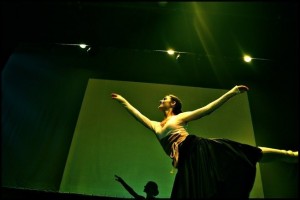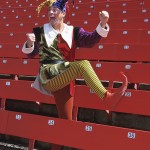Dance your PhD 2013 – a dancer’s view
Just recently, the winners of this year’s Dance Your PhD Contest was announced. Here Alicia González Martínez, undergraduate student in medicine and semi-professional dancer, shares her thoughts about the winners.
Dance, as a human manifestation, has often been the subject of study by science. Scientists have studied the desirable or undesirable effects of dance as a human activity. Some examples of titles are “Development and evaluation of a dance-based exercise therapy for patients with haemophilia”, “The effects of delayed menarche in different contexts: Dance and non-dance students” and “Prevalence of Eating Disorders amongst Dancers”.
But this time, it’s different. This time, the dancers use scientific studies as the object of their dancing. The relationship is symbiotic: PhD theory is expressed through body language visual similes. The dancers transmit scientific progress through their personal manifestation.
Dance your PhD contest has just celebrated its sixth edition and there are already winners. Undoubtedly, the most striking feature of the contest is the topic, explaining science through dance … what a singular idea! But it is peculiar as well the multicultural show, different styles of dance, different clothes, and different movements.
Sperm competition between brothers and female choice from Cedric Kai Wei Tan on Vimeo.
The winner of Dance your PhD 2013 uses original pop-rock music and ballet movements in European environments and open spaces like the countryside, sports apparel and rhythmic gymnastics, originally designed to promote grace of movement, muscular flexibility and good posture. In this case, all this sprinkled with a great sense of humour, showing what is happening in the experiments. It is a good example of team work.
The ‘FRETting’ tendency of the bacterial protein! from Ambalika Khadria on Vimeo.
The Chemistry winner shows a kind of Turkish dance with suggestive movements full of sensuality and symbolic elements. Their simple outfits make you think of the Horon dance, a Turkish folk dance originally performed by men only dressed in black with silver trimmings. The dance takes place indoors with the help of ordinary objects like light bulbs, masks, chairs or hats, which make the choreography instructive and link science and everyday life. It is a nice demonstration of the method he uses in his PhD.
Tim Hunter Energy Based Fatigue from Tim Hunter on Vimeo.
The Physics winner uses body movements to illustrate physical mechanisms, formulae and even graphs. They use minimalist costumes with significant details. Arms and legs take an important role in this demonstration. The dancers are middle-aged people who combine ballet based movements with ballroom and disco dances in a futuristic setting. The performance is very educational.
Dance your PhD: Sleep loss in a social world from Tina Sundelin on Vimeo.
The Social Sciences winner shows a contemporary choreography performed in casual clothes during an ordinary day. This is a very good example of how energy, or the lack of it, affects dancing and everyday life; how the same dance can transmit one thing or another to the audience depending on the intensity of the movements. Pirouettes and jetés cannot be done properly without enough sleep. Work, social relationships also need to be focused on. Unpredictable changes in rhythm, speed and direction are the basis of contemporary dance and here they are used to show the different reactions to the same situation, with or without energy. Thus, it is a perfect match with the topic.
The Super-Hero Salsa: Understanding the Role of MYCN in Neuroblastoma using a Systems Biology Approach. (Dance your PhD 2013) from Andres Florez on Vimeo.
Salsa, a popular kind of social dance, with origins in Latin-America, is used in this phD thesis. The Cuban Casino style of salsa dancing involves significant movements above the waist using the shoulders and the ribcage. It represents the cell cycle. But, in this particular case, the cancer cell interrupts the rhythm of the group and makes the cell cycle go faster and wrong. It takes the role of the lead dancer and starts modifying the normal cell function while recruiting more cancer cells. Dancers use colourful costumes, the performance is fun and the message is quite clear. Dancing is used again as a communication tool to imagine what is happening in the cell.
As we can see in all the videos, dancing can help to communicate science, making it fun and desirable for everyone. Art and science can definitely work together!
Alicia González Martínez, undergraduate student, 4th year medicine, Castilla-La Mancha University, Ciudad Real, Spain, and a participant in the Amgen Scholars Program at Karolinska Institutet 2013. She has an advanced certificate in classical ballet by the “Royal Academy of Dance” (Distinction) as well as an advanced certificate in Spanish and Flamenco dance by the “Spanish Dance Society” (Distinction). Alicia is currently focusing on researching new ways of combine dancing with scenic arts in her group “Ojos Venecia” – here a video from one of their performances.
- Claire Price of Crastina receives outreach award from Royal Society of Biology - October 25, 2020
- Agile Science student project at Brussels Engineering School ECAM: “We can’t wait to try it again!” - August 28, 2020
- Create an infographic in the Lifeology SciArt Infographic Challenge - June 16, 2020
- Adam Ruben – The scientist that teaches undergraduate students comedy - March 27, 2020
- Sam Gregson, Bad Boy of Science: “Comedy helps to bridge the gap” - March 10, 2020
- The Coolest Science Merchandise of 2019 - December 16, 2019
- Science Media Centre (UK) offers guide on dealing with online harassment in academia - November 26, 2019
- Agile project management taught to students and researchers at Karolinska Institutet - September 20, 2019
- Stefan Jansson: Improve your credibility! (Crastina Column, September 2019) - September 6, 2019
- The People’s Poet: Silke Kramprich, tech communicator - August 31, 2019






Trackbacks & Pingbacks
[…] you have seen before, we like dancing here at crastina.se. Recently, an FB friend sent me the image below which—for […]
Leave a Reply
Want to join the discussion?Feel free to contribute!